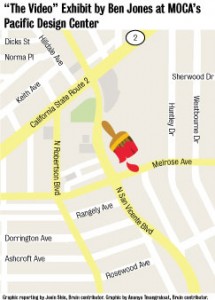This week, I was hugged by a video. What?
I visited the Museum of Contemporary Art’s Pacific Design Center, located in West Hollywood, for an exhibit called “Ben Jones: The Video,” which features a collection of artist Ben Jones’ videos and paintings. His style of artwork in this exhibition attempts to combine the standard paint-on-canvas method with video action. Running until Feb. 24, the solo exhibit is worth a trip.
Though video art has been done before, finding its roots in the 1960s with Nam June Paik’s iconic television sets, there is something particularly engaging about Jones’ work that relates to modern times. Jones is an artist from Pittsburgh, Pa., who has experience working with several different types of creative media, including video, animation and painting. His show at the Pacific Design Center is unlike most other video art I’ve seen because it’s more like a moving painting than a storytelling video clip.
Other contemporary works involving video require the viewer to figure out a certain story or message conveyed by the film, and because there are many other gallery pieces to see, I usually end up walking past these pieces simply because I don’t want to wait for something exciting to happen.
But Jones’ work doesn’t do that. It combines the ease of viewing paintings with the excitement of motion, which proves to be visually enticing and dangerously mesmerizing. The colors are fantastically vibrant and reminiscent of lights at a rave, while the movement is strangely seductive with curves and geometric waves continuing in a symmetrical pattern. I was so captivated by the gently pulsing colors that it almost felt like the projection was giving me a comforting virtual embrace.
Now, before anyone asks me what type of medication I took that morning, I’ll first say that I’m aware I wasn’t actually physically hugged by a piece of artwork, but my mind was put at ease by the cool vibes and insane colors of the video art. For a moment, I forgot about my busy schedule and whatever exams or papers I had due in a week. It was like giving my mind a breath of fresh air.
Aside from being visually stunning and mentally calming (for myself at least), Jones’ work is also relevant to the now by reflecting today’s society. Today, the meaning behind artwork is not as important as its aesthetic value. In a time when movies, video games and television are all trying to reel in attention by using contrived methods like catchy slogans and neon signs, there is little room left for quiet, boring art to make a statement.
I feel that my generation seems especially apathetic about visual arts; most of us are either bored by traditional works from before the 20th century or aren’t interested enough to figure out what modern art means anymore. Our generation has an extremely short attention span due to media outlets competing for our attention. If something isn’t cool, different, unique, etcetera, most of us young folks would just move on to the next clever whatever.
Jones’ work is entertaining while still conserving artistic value, which is why I enjoyed it so much. His work fits in with other forms of entertainment today – it’s pretty, it’s dynamic, it’s eye-catching, and best of all, it doesn’t provoke thought unless you want it to. It’s art with such strong visuals that the viewer doesn’t need to ponder the deeper significance behind the piece to appreciate the work.
I don’t want to belittle the importance of meaning behind artwork, but I believe that in order for art to be more accessible, it needs to be tailored to modern times. Our attention spans are getting shorter, but Jones’ artwork fits right in with our mindsets – it’s relevant without trying.
How do you think art can stay relevant?
Email Shin at jshin@media.ucla.edu .

